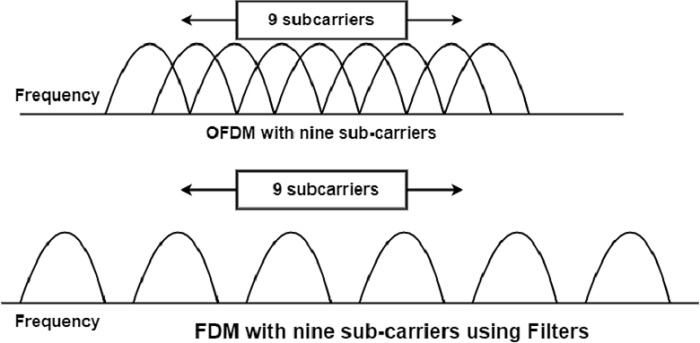
 Data Structure
Data Structure Networking
Networking RDBMS
RDBMS Operating System
Operating System Java
Java MS Excel
MS Excel iOS
iOS HTML
HTML CSS
CSS Android
Android Python
Python C Programming
C Programming C++
C++ C#
C# MongoDB
MongoDB MySQL
MySQL Javascript
Javascript PHP
PHP
- Selected Reading
- UPSC IAS Exams Notes
- Developer's Best Practices
- Questions and Answers
- Effective Resume Writing
- HR Interview Questions
- Computer Glossary
- Who is Who
Explain the Orthogonal Frequency Division Multiplexing in Computer Network.
Frequency Division Multiplexing (FDM) is a technology that transmits multiple signals simultaneously over a single transmission path, such as cable or wireless system. Each carrier is modulated by the data such as text, voice, video etc. Orthogonal FDM spread spectrum technique distributes the data over a large number of carriers that are spaced apart at precise frequencies. This spacing provides the “orthogonality.” This technique, which avoids the demodulators from seeing frequencies other than their own.
The basic approach of OFDM is shown in the figure below −

The benefit of OFDM is high spectral efficiency, resiliency due to RF interference and lower multi-path distortion. OFDM is a transmission method that has been around for years but only became popular due to the development of digital signal processors (DSPs) that can handle its heavy digital processing requirements. OFDM is being implemented in a broadband wireless access system as a way to overcome wireless transmission problems and to improve bandwidth.
OFDM is also used in wireless LAN as specified by the IEEE 802.11a standards. It is also used for wireless digital radio and T.V. transmissions, particularly in Europe. OFDM is sometimes called multi-carrier or discrete multi-tone modulation.
OFDM is similar to FDM but much more spectrally efficient by spacing the sub-channels much closer together until they are overlapping. This is done by finding orthogonal frequencies. It means that they are perpendicular in a mathematical sense, allowing the spectrum of each sub-channel to overlap another without interfering.
Advantages of OFDM
It is more resistant to frequency selective fading than single carrier systems because it splits the whole channel into various narrowband signals that are concerned independently as flat fading sub-channels.
There is one problem in CDMA systems was the difficulty of the channel equalization which had to be used across the entire channel. The advantage of OFDM is that using various sub-channels, the channel equalization turns simpler.
It is very flexible to inter-symbol and inter-frame interference. This results from the low data cost on each of the sub-channels.

